Add this eBook to your basket to receive access to all 427 records. Our indexes include entries for the spelling hanbury. In the period you have requested, we have the following 427 records (displaying 411 to 420): These sample scans are from the original record. You will get scans of the full pages or articles where the surname you searched for has been found. Your web browser may prevent the sample windows from opening; in this case please change your browser settings to allow pop-up windows from this site. Officers of the British Army and of the Indian Army
(1934)
The Half-Yearly Army List, issued By Authority, 30 June 1934, lists all officers in active service at that date, and this list was evidence of the status and rank of the officers contained in it. The entries are set out as a gradation list, by rank, from field-marshals to lieutenants, and within each rank in order of seniority at that rank. Each officer's name (surname first, in capitals, then christian name and present rank (with date of achieving that rank) and regiment &c. are given, for convenience, in bold type, with any national decorations in italics after the name. Each entry also gives date of birth, number of days service in the ranks, dates of service in each rank of officer, particular offices and postings (with dates) and, where appropriate, a summary of war service, and medals. For all but the oldest of the officers then serving, the war service details are for the Great War (1914-1921), and campaigns in Iraq, Waziristan, and the North West Frontier of India. War services are not given in this edition for Indian Army officers, except in that their entries are preceded by a crossed swords symbol where they have seen war service in a theatre of war overseas. After the gradation list of officers, there is a section for the Royal Malta Artillery; and then (pages 1152 to 1185) warrant officers - staff or garrison serjeant-majors, educational serjeant-majors, serjeant-major (physical training and educational) instructors, regimental serjeant-majors (and corporal-majors, farrier-serjeant majors, master gunners, assistant instructors in gunnery, experimental serjeant-majors, artillery clerks, farrier-serjeant-majors, artificer serjeant-majors, clerks of works, mechanist, superintending clerks, draughtsmen, 1st class staff serjeant-majors, transport, supply, conductors, sub-conductors, armourers, armament artificers, headmasters, schoolmasters, marine gunners, and bandmasters. The section for the Royal Army Chaplains' Department lists all chaplains (1st to 3rd class); and that for Queen Alexandra's Imperial Military Nursing Service has all matrons, sisters and staff nurses. The lists of nurses do not give date of birth: all are unmarried. The book concludes with the Yeomen of the Guard, the Honourable Company of Gentlemen-at-Arms, and the King's Body Guard for Scotland, in each case giving name (surname and initials, not christian names), honours, name of late regiment, and date of appointment.
| Sample scan, click to enlarge
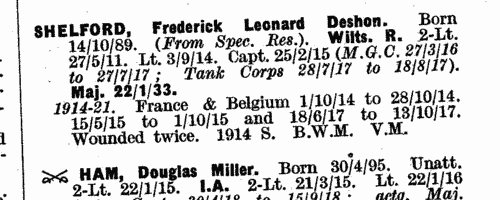
| Members of Cambridge University
(1935)
The Cambridge University Calendar for 1935-1936 includes this list of all living members of the university, i. e. not only undergraduates and members of staff, but also all surviving graduates from earlier generations. The names are arranged alphabetically by surname, then by college in order of foundation, and under the particular colleges by order of seniority of the B. A. degree. Surnames are given, initials, name of college, and then the years of graduating B. A. and M. A. Where a change of name had occurred since matriculation, the original name is inserted in brackets. For undergraduates the term of matriculation is given in square brackets with an M for Michaelmas, L for Lent or E for Easter. An asterisk before a surname indicates a member of the Senate. Names which appeared on the roll of the Regent House promulgated in November 1934 are marked with a dagger. Further degrees, such as PHD, MB, BCHIR, MD, &c. are listed in smaller capitals with the year conferred. | Sample scan, click to enlarge
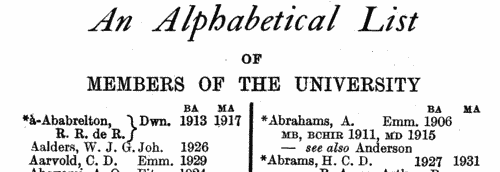
| Imperial Service Medal
(1945)
The Central Chancery of the Orders of Knighthood at St James's Palace announced these awards by king George VI of the Imperial Service Medal to members of the Home Civil Service. The names are arranged alphabetically by surname (in capitals) and christian names, with office or rank in the service. | Sample scan, click to enlarge
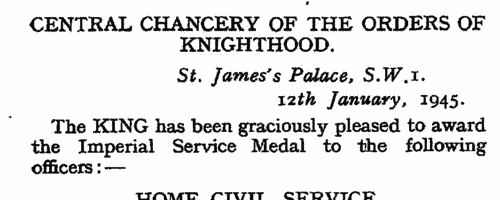
| Doctors in London
(1948)
The Medical Directory was split into several sections. The London section covered all medical practitioners resident within the London postal district. Each year a schedule was sent to each doctor to be returned to the publishers, so as to keep the directory up to date. In the directory the doctor's name is given first, in bold, surname first, in capitals; then current address. Next are the qualifications; the italic abbreviations in parentheses following the qualifications indicate the medical school at which they were gained. Then there is a list of posts and honours within the profession, starting with those then current; previous posts are preceded by the word 'late'. Finally, brief details are given of any publications. | Sample scan, click to enlarge
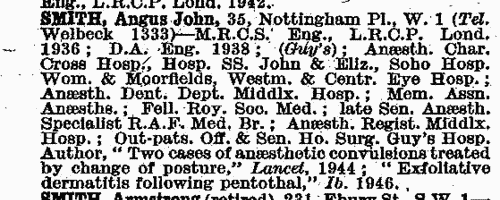
| Doctors in Military Service
(1948)
The Medical Directory was split into several sections. This section covered medical practitioners in the Navy, the Army, the Indian Army and the Royal Air Force. The doctor's name is given first, in bold, surname first, in capitals; then current address. Next are the qualifications; the italic abbreviations in parentheses following the qualifications indicate the medical school at which they were gained. Then there is a list of posts and honours within the profession, starting with those then current; previous posts are preceded by the word 'late'. Finally, brief details are given of any publications. | Sample scan, click to enlarge
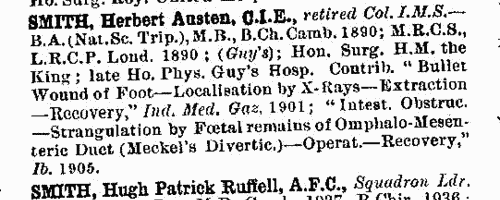
| Prominent Inhabitants of Birmingham
(1949)
The Birmingham Post Year Book and Who's Who is an annual publication seeking to give comprehensive information about the city's organizations and its eminent residents. The Year Book has separate sections dealing with the City Council; the Municipal Elections; Municipal Departments; The High Court of Justice; Members of Parliament for the City; Political Associations; Government Departments; Trade and Industry; Birmingham Consular Association; Banks and Branches; Birmingham Stock Exchange; Restaurants and Cafes; Health; Churches and Religious Congregations; Freemasons; Education; Child Care; Youth; Cultural Activities; British Broadcasting Corporation; Sports and Pastimes; Philanthropic and Kindred Institutions; County and Kindred Societies; International Societies; United Nations Association; Clubs; Transport; The Forces; Toc H.; Royal Antediluvian Order of Buffaloes; Electricity and Gas Boards; Law List; Chartered Accountants; Incorporated Accountants; Certified and Corporate Accountants; Chartered Secretaries; Surveyors, Auctioneers, Land Agents and Valuers; Architects; Civil Engineers; Mechanical Engineers; Electrical Engineers; and Old Boys' Associations. For most organizations, names and addresses of secretaries and other officers are given. Full lists of professional people are given in their sections, with addresses. Then there is the Who's Who in Birmingham, which (with an In Memoriam section for those who had died in the last year) usually gives full name (surname first, in capitals, in bold), date and place of birth (and often father's name), if married the year and name of spouse (and sometimes father's name); numbers of sons and daughters; a brief description of career, recreations, and current address. | Sample scan, click to enlarge
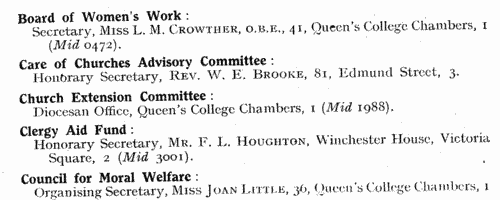
| Chemists
(1950)
The Royal Institute of Chemistry was founded in 1877, and was open only to British subjects (and also, in due course, to citizens of the newly-created Republic of Ireland). Associates of the institute (A. R. I. C.) qualified either by studying chemistry, physics, mathematics and an optional science for the institute's examination (which insisted on a high standard of practical laboratory efficiency); or by obtaining good honours degrees or equivalent qualifications, with chemistry as principal subject, and having undergone training in allied sciences. Associates of at least three years' standing could then be admitted to the Fellowship (F. R. I. C.) either by taking a further examination in a special branch of chemistry, or by submitting the results of work or evidence of experience sufficient to justify the Council in granting exemption from such further examination. This register of fellows and associates, correct to 31 August 1950, contains 11,545 names, arranged alphabetically, surname first (in capitals), with qualifications, current address, telephone number, and (in italics) a brief description of present post in the chemical industry. Finally, year of admission as associate (A.) (and, where appropriate, fellow (F.) is given on the right-hand side. With this may appear the notation (x) for a fellow of the Chemical Society, (y) for a member of the Society of Chemical Industry, or (z) for a joint subscriber to all three chartered bodies. | Sample scan, click to enlarge
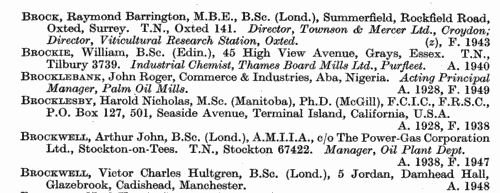
| Estates of the Deceased: Notices under the Trustee Act
(1950)
Under the Trustee Act 1925 s. 27, notices were gazetted giving the names of deceased (surname first, in capitals); address, description, and date of death; names, addresses and occupations of persons to whom notices of claims against the estate were to be given, and names (in brackets) of personal representatives; and the date on or before which notices of claim were to be given. May 1950. | Sample scan, click to enlarge

| Guy's Doctors
(1952)
Guy's Hospital, London, issued an annual Hospital Directory listing doctors at home and abroad, and graduates and licentiates in dental surgery who were qualified at the hospital and/or subsequently worked there. The names are listed alphabetically by surname (in capitals) and full name, with qualifications and appointments and current address (and often telephone number). Subscribers to the hospital Gazette and Directory are indicated with an asterisk. | Sample scan, click to enlarge

| Past and present students of Clare College, Cambridge
(1952)
The College Clerk at Clare College issued this list of 'all those still living who have been admitted and have come into residence in Clare down to and including the admissions of the year 1951'. Each entry gives year of admission, full name (surname first, in capitals), address as of 1952, and degree(s). | Sample scan, click to enlarge
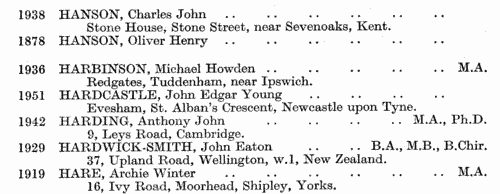
|
Research your ancestry, family history, genealogy and one-name study by direct access to original records and archives indexed by surname.
|











